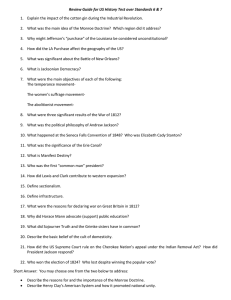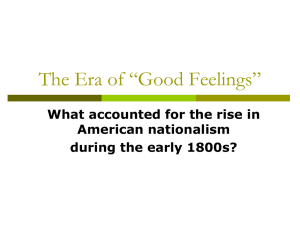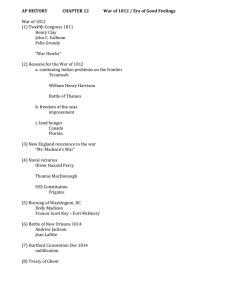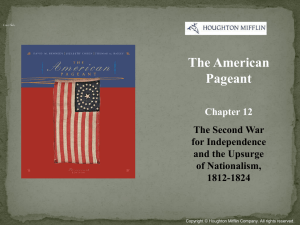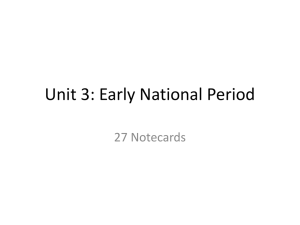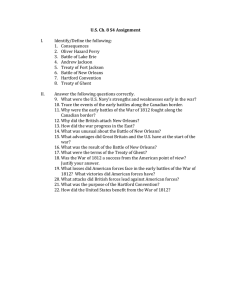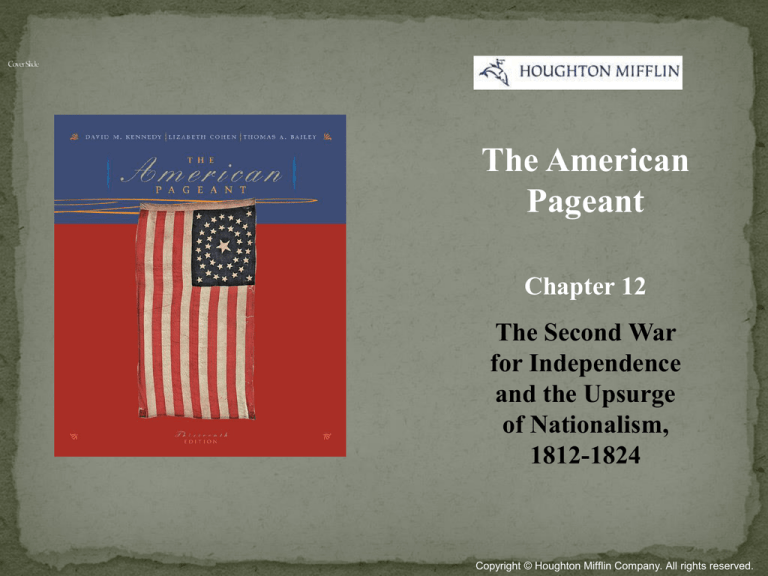
The American
Pageant
Chapter 12
The Second War
for Independence
and the Upsurge
of Nationalism,
1812-1824
Copyright © Houghton Mifflin Company. All rights reserved.
Due to widespread disunity, the War of 1812 ranks as
one of America’s worst fought wars.
the regular army was very bad and scattered and had
old, senile generals, and the offensive strategy against
Canada was especially poorly conceived.
Invasion of Canada (3-part invasion)
1.
2.
3.
•
•
Starting from Detroit
Starting from Niagra
Starting from Lake Champlain
Three forces were held off by the British
An American raid and burning of gov’t building in
York (Toronto) only encouraged retaliation
Perry fought an engagement and beat the British off of
Lake Erie
This prepared the way for General William Henry
Harrison’s military victory at the Battle of Thames
River (near Detroit)…Tecumesh is killed.
1814: US defeats British fleet on Lake Champlain
British forced into retreat and had to abandon plan to
invade NY and New England
British march into D.C. and set fire to the White
House, Capitol and gov’t buildings
British attempt to take Baltimore, but Fort McHenry
holds out…Star Spangled Banner
British Sacking Washington, 1814
Thinking that the British would attack Baltimore, the government failed to provide an adequate
defense of Washington. On August 25, 1814, after their victory at Bladensburg, the British
entered Washington unopposed, "for the barbarous purpose of destroying the city," confessed a
British officer. After setting much of the city ablaze, the British withdrew on August 26 and
President Madison returned the following day. (Anne S. K. Brown Military Collection, Brown
University Library)
Copyright © Houghton Mifflin Company. All rights reserved.
Oh, say can you see by the dawn's early
light
What so proudly we hailed at the
twilight's last gleaming?
Whose broad stripes and bright stars
thru the perilous fight,
O'er the ramparts we watched were so
gallantly streaming?
And the rocket's red glare, the bombs
bursting in air,
Gave proof through the night that our
flag was still there.
Oh, say does that star-spangled
banner yet wave
O'er the land of the free and the home
of the brave?
Andrew Jackson leads troops
March 1814: Battle of Horseshoe Bend (Alabama)
Jackson eliminates ally of GB—Creek Nation
Opens land to White settlers
British attempt to control Mississippi River was halted
by Jackson leading frontiersmen. Free blacks, &
Creoles
Victory at New Orleans made Andrew Jackson a
national hero & symbol of the emerging West.
Battles impressive, but fought after the Treaty of Ghent
was signed
Jackson at the Battle of New Orleans, artist unknown
Ballou's Pictorial Drawing-Room Companion depicts the Battle of New Orleans, the
last campaign of the War of 1812. Andrew Jackson's troops--army regulars,
Tennessee and Kentucky volunteers, and two companies of African American
volunteers from New Orleans--held off the better-trained British troops in January of
1815. The battle made Andrew Jackson a national hero. (Historic New Orleans
Collection)
Copyright © Houghton Mifflin Company. All rights reserved.
Agreement signed by the Americans and the British
agreed to stop fighting
potentially led to the end of the War of 1812
was signed before the Battle of New Orleans
Americans did not learn of the treaty until after the
victory at New Orleans
Americans assumed the "victory" for the war
British signed quickly because they were more
concerned with European affairs
As the capture of New Orleans seemed imminent, Massachusetts,
Connecticut, New Hampshire, Vermont, and Rhode Island secretly met in
Hartford from December 15, 1814 to January 5, 1815
Why? to discuss their grievances & to seek redress for their wrongs.
few talked about secession
most wanted financial assistance from Washington to compensate for lost trade, and
an amendment requiring a 2/3 majority for all declarations of embargos, except
during invasion.
Three special envoys from Mass. went to D.C.
they were greeted with the news from New Orleans
their mission failed, and they sank away in disgrace and into obscurity.
The Hartford Convention proved to be the death of the Federalist Party, as their
last presidential nomination was trounced by James Monroe in 1816.
During the War of 1812
A) some New England Federalists, unhappy with
the war with England, met and planned to secede
from the Union
B) the British had the opportunity, but declined to
burn buildings in the capital of Washington, D.C.
C) the Americans lost a major naval battle on
Lake Erie
D) the British were unable to effectively blockade
U.S. ports
E) U.S. troops finally succeeded in their third
attempt to invade Canada
A) some New England Federalists, unhappy with the war
with England, met and planned to secede from the
Union
Explanation: In December 1814 Federalists from several
New England states met to consider secession from the
U.S and ended up recommending seven amendments to
the Constitution. Their efforts lost momentum with the
signing of the Treaty of Ghent, but the Federalist Party
was discredited for the meeting and no longer was a
force in national politics. The British burned several
buildings in Washington, D.C., including the Capitol
and the White House. The U.S. successfully battled the
British on Lake Erie at Put-in-Bay in 1813, but failed in all
three invasions attempts of Canada. The British
blockade of U.S. ports began in 1812 and was largely
effective.
The War of 1812
Commodore Perry
abandoning his flagship
during fighting on Lake
Erie
Putting the War of 1812 into perspective:
= a small war involving ~ 6k Americans
killed or wounded
FYI: Napoleon invaded Russia in 1812 with
500k men
Madison tried to invade Canada with about 5,000 men
Americans proved that they could stand up for what
they felt was right
naval officers like Perry & MacDonough gained new
respect
American diplomats were treated with more respect
than before
Federalist Party dies forever
New war heroes, like Andrew Jackson and William Henry
Harrison, emerge
Manufacturing prospered during the British blockade
there was nothing else to do
Conflict with Britain grows
Why? Incidents like the burning of Washington added to
hatred of the nation years after the war
Canadians felt betrayed by the Treaty of Ghent
Why? No Indian buffer state achieved
Indians, left by the British, were forced to make treaties where
they could
Rush-Bagot Treaty (1817)
after a heated naval arms race in the Great Lakes,
b/w U.S. and GB provided the world’s longest unfortified
boundary (5,527 mi.)
After Napoleon’s defeat at Waterloo
America looked west to further expand
The Federalist Party emerged during the struggle over the
adoption of the Constitution in the late 1780s but had ceased to
be a major force in American political life by 1820. From which
two of the following groups did the Federalists tend to draw
their support?
I. small farmers from the southern states
II. residents of the northeast
III. bankers and large merchants
IV. those believing in a narrow, or strict, interpretation of
the Constitution
V. recent immigrants to the U.S.
A) I and II
B) II and IV
C) II and III
D) II and V
E) III and IV
C) II and III
Explanation: Federalists
dominated political life in the
1790s but saw their influence wane
as the 19th century progressed.
Their main support came from
states in the northeast and
included merchants and bankers.
Led by Alexander Hamilton,
Federalists believed in a broad, or
"loose construction" approach to
the Constitution to allow the
national government to expand its
powers to deal with new
situations. Many former
Federalists joined the Whig Party
which emerged during the 1830s.
By the election of 1816,
Federalists had lost their ability
to gain national votes. Federalist
Rufus King opposed James
Monroe for president.
American Authors gained international recognition:
Washington Irving (Rumpelstiltskin, The Knickerbocker
Tales such as The Legend of Sleepy Hollow)
James Fenimore Cooper (The Leatherstocking Tales
which included The Last of the Mohicans)
Background:
British competitors dumped their goods onto America
at cheap prices
America responded with the Tariff of 1816
first in U.S. history designed for protection, which put a 20-
25% tariff on dutiable imports
Henry Clay devises the American System
1824: Henry Clay
began with a strong banking system
advocated a protective tariff behind which eastern manufacturing
would flourish.
included a network of roads and canals
especially in the Ohio Valley
Funded through tariffs
Foodstuffs and raw materials would flow from the South and West to
the North and East.
Lack of effective transportation had been one of the problems of
the War of 1812
Congress sought to distribute $1.5 million to the states for
internal improvements Bonus Bill of 1817
Madison vetoed it
Said it was unconstitutional,
Made states look for their own money to build the badly needed
roads.
The American System
WEST got roads, canals, and
federal aide.
EAST got the backing of
protective tariffs from the
West.
SOUTH ??
Monroe's presidency (1817-1825)
people had good feelings caused by:
nationalistic pride after the Battle of New Orleans &
second war for Independence with British
Only one political party was present
On the surface everything looked fine
Underneath there was trouble
conflict over slavery was appearing
sectionalism was inevitable
Missouri Compromise had a very dampening effect on
those good feelings
The Election of 1816
[The Demise of the Federalist Party!]
South did not like the tariff
Said it only benefited the North & made the South pay
higher prices
South disliked the internal improvements linking the
North and West
didn’t see any benefits in paying taxes for roads & canals
in other states
The Panic of 1819
CAUSES???
over-
speculation in
land prices
This caused the
Bank of the
United States to
fall heavily into
debt
What was it?
a paralyzing economic panic (the first since
Washington’s times)
It engulfed the U.S., bringing deflation,
depression, bankruptcies, bank failures, unemployment,
soup kitchens, and overcrowded debtors’ prisons
Started predictable chain of panics or recessions
economic panic occurred every 20 years during the 1800s
(panics occurred during 1819, 1837, 1857, 1873, 1893)
Who was hit hard?
The West
the Bank of the U.S. was viewed as the cause
Background:
B/w 1791-1819:
9 frontier states had joined the original 13
Why?
Cheap land
elimination of the Indian menace
“Ohio Fever”
need for land by the tobacco farmers, who exhausted their
lands
Transportation:
Cumberland Road:
begun in 1811 & ran ultimately from western Maryland to Illinois
Steamboats:
first appeared on western waters appeared in 1811.
Political influence:
West, still not populous= politically weak
forced to ally itself with other sections
Land Act of 1820:
Authorized a buyer to purchase 80 acres of land at a
minimum of $1.25 an acre in cash
Replaced the Land Act of 1800 (allowed Americans to buy 160
acres of land (minimum) at $2.00 an acre over a period of four
years)
result of the depression, bank failures, bankruptcies, soup
kitchens, unemployment, etc. of 1819
West demanded & slowly got cheap transportation as well
Sectional tensions b/w the North & the South came to
a boil when Missouri wanted to become a slave state.
Missouri met all the requirements of becoming a state,
but…
the House of Reps. thwarted statehood plans by
proposing the Tallmadge Amendment
no more slaves be brought into Missouri
also provided for the gradual emancipation of children born
to slave parents already in Missouri
Shot down in the Senate
Southerners saw this as a threat
Believed that if Northerners could wipe out slavery in
Missouri, they might try to do it elsewhere
North was starting to get more prosperous & populous
than the South
Missouri Compromise
Missouri would be admitted as a slave state while
Maine would be admitted as a free state= balance (it went from 11
free states and 11 slave states to 12 and 12).
All new states north of the 36°30’ line would be free, new states
southward would be slave
The North & South gained something, though neither was totally
happy
Compromise worked for many years
Election of 1820:
Monroe should have been doomed after the 1819 panic & the
Missouri problem
Monroe was popular, and the Federalist Party = weak
he won in by one vote (unanimity was reserved for Washington).
The Compromise of 1820:
A Firebell in the Night!
The Election of 1820
Judicial Nationalism =
When the Supreme Court (“judicial”) helped to bolster
the power of the government (federal government
“nationalism) at the expense of the states.
John Marshall’s reign as Chief Justice practiced this
McCulloch v. Maryland
involving the state of Maryland & their right to tax the
federal bank
sets precedent for the "loose clause“
increased power of Fed, government.
Gibbons v Ogden (1824)
case involved New York trying to grant a monopoly on waterborne
trade between New York and New Jersey
Judge Marshall reminded the state of New York that the
Constitution gives Congress alone the control of interstate
commerce
major blow on states' rights.
Fletcher v. Peck (1810)
Georgia legislature, swayed by a bribe, gave 35 million acres of
Mississippi land to private speculators
The next legislature cancelled the original ruling.
Supreme Court decided the grant was a contract and state law
cannot impair contracts.
One of the first court cases to illustrate the power of the
Supreme Court to invalidate state laws conflicting with the
federal Constitution
decision protected the peoples' rights against popular pressures.
Dartmouth College vs. Woodward (1819):
Dartmouth had been granted a charter by King George
III
New Hampshire had tried to change it.
Dartmouth appealed, using alumni Daniel Webster to
work as lawyer
Marshall ruled that the original charter must stand.
It was a contract, and the Constitution protected those and
overruled state rulings.
Marshall’s rulings gave the Supreme Court its
powers & greatly strengthened the federal
government
Treaty of 1818:
northern boundary of the Louisiana Purchase = the 49th
parallel
provided for a ten-year joint occupation of the Oregon
Territory with Britain
Revolutions break out in South & Central America
Spanish troops in Florida withdraw to put down the
rebellions
Indian attacks ravaged American land
Indians would then retreat back to Spanish territory.
Andrew Jackson
swept across the Florida border
hanged two Indian chiefs
executed two British subjects for assisting Indians
seized St. Marks & Pensacola.
Monroe consulted his cabinet: what to do against
Jackson?
All wanted to punish him except for John Quincy
Adams, who demanded huge concessions from Spain.
The Florida Purchase Treaty of 1819
Spain cede Florida and shadowy claims to Oregon in
exchange for Texas
U.S. paid $5 million to Spain for Florida.
The doctrines' two main points were
1) There would be no colonization of the western
hemisphere
2) Nonintervention from the rest of the world in the
western hemisphere.
Showed a strong sense of nationalism, creating
national pride
Helped establish US as a world power.
Treaty of Fort Jackson imposed on Creek nation by Andrew Jackson
Andrew Jackson imposed the Treaty of Fort Jackson on the Creek nation, ending the campaign
against the Red Sticks. The treaty required the Creeks to pay the costs of the war, which
Jackson estimated as the equivalent of 20 million acres. In moving the Creeks out of what is
now central Alabama, Jackson initiated the Indians' forced removal from the south. Ironically,
of the thirty-five chiefs who made their mark on the treaty, part of which is shown here, only
one was a member of the Creek nation. (National Archives)
Copyright © Houghton Mifflin Company. All rights reserved.

